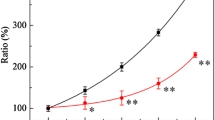Abstract
Ionizing radiation indirectly causes oxidative stress in cells via reactive oxygen species (ROS), such as hydroxyl radicals (OH−) generated by the radiolysis of water. We investigated how the catalase function was affected by ionizing radiation and analyzed the phenotype of mutants with a disrupted catalase gene in Saccharomyces cerevisiae exposed to radiation. The wild-type yeast strain and isogenic mutants with disrupted catalase genes were exposed to various doses of 60Co gamma-rays. There was no difference between the wild-type strain and the cta1 disruption mutant following exposure to gamma-ray irradiation. In contrast, there was a significant decrease in the ctt1 disruption mutant, suggesting that this strain exhibited decreased survival on gamma-ray exposure compared with other strains. In all three strains, stationary phase cells were more tolerant to the exposure of gamma-rays than exponential phase cells, whereas the catalase activity in the wild-type strain and cta1 disruption mutant was higher in the stationary phase than in the exponential phase. These data suggest a correlation between catalase activity and survival following gamma-ray exposure. However, this correlation was not clear in the ctt1 disruption mutant, suggesting that other factors are involved in the tolerance to ROS induced by irradiation.



Similar content being viewed by others
References
Abbott DA, Suir E, Duong GH (2009) Catalase overexpression reduces lactic acid-induced oxidative stress in saccharomyces cerevisiae. Appl Environ Microbiol 75:2320–2325
Akada R, Yamamoto J, Yamashita I (1997) Screening and identification of yeast sequences that cause growth inhibition when overexpressed. Mol Gen Genet 254:267–274
Amari F, Fettouche A, Samra MA (2008) Antioxidant small molecules confer variable protection against oxidative damage in yeast mutants. J Agric Food Chem 56:11740–11751
Beers RF, Sizer IW (1952) A spectrophotometric method for measuring the breakdown of hydrogen peroxide by catalase. J Biol Chem 195:133–140
Charles JS, Hazkani-Covo E, Yin Y et al (2012) High-resolution genome-wide analysis of irradiated (UV and g-Rays) diploid yeast cells reveals a high frequency of genomic loss of heterozygosity (LOH) events. Genetics 190:1267–1284
Herrero E, Ros J, Bellí G et al (2008) Redox control and oxidative stress in yeast cells. Biochem Biophys Acta 1780:1217–1235
Ito H, Fukuda Y, Murata K (1983) Transformation of intact yeast cells treated with alkali cations. J Bacterial 153:163–168
Lacerda CMS, Martins EMN, Resende MA (2011) Gamma radiation effects on sporothrix schenckii yeast cells. Mycopathologia 171:395–401
Lee JH, Choi IY, Kil IS et al (2001) Protective role of superoxide dismutases against ionizing radiation in yeast. Biochim Biophys Acta 1526:191–198
Lee SM, Park JW (1998) A yeast mutant lacking thiol-dependent protector protein is hypersensitive to menadione. Biochim Biophys Acta 1382:167–175
Lu J, Holmgren A (2014) The thioredoxin antioxidant system. Free Rad Bio Med 66:75–87
Mate MJ, Zamocky M, Nykyri LM, Herzog C, Alzari PM, Betzel C, Koller F, Fita I (1999) Structure of catalase-A from Saccharomyces cerevisiae. J Mol Biol 268:135–149
Petrova VY, Drescher D, Kujumdziev AV (2004) Dual targeting of yeast catalase A to peroxisomes and mitochondria. Biochem J 380:393–400
Ross SJ, Findlay VJ, Malakasi B, Morgan BA (2000) Thioredoxin peroxidase is required for the transcriptional response to oxidative stress in budding yeast. Mol Bio Cell 11:2631–2642
Rowe LA, Degtyareva N, Doetsch PW (2012) Yap1: a DNA damage responder in Saccharomyces cerevisiae. Mech Ageing Dev 133:147–156
Sasano Y, Watanabe D, Ukibe K, Inai T, Ohtsu I, Shimoi H, Takagi H (2012) Overexpression of the yeast transcription activator Msn2 confers furfural resistance and increases the initial fermentation rate in ethanol production. J Biosci Bioeng 113:451–455
Shingo I, Yoshiharu I, Akira K (1996) Importance of catalase in the adaptive response to hydrogen peroxide analysis of acatalasaemic Saccharomyces cerevisiae. Biochem J 320:61–67
Spevak W, Fessl F, Rytka J et al (1983) Isolation of the catalase T structural gene of Saccharomyces cerevisiae by functional complementation. Mol Cell Bio 3:1545–1551
Zimnlak P, Hartter E, Woloszczuk W (1976) Catalase biosynthesis in yeast: formation of catalase A and catalase T during oxygen adaptation of Saccharomyces cerevisiae. Eur J Biochem 71:393–398
Author information
Authors and Affiliations
Corresponding author
Rights and permissions
About this article
Cite this article
Nishimoto, T., Furuta, M., Kataoka, M. et al. Important Role of Catalase in the Cellular Response of the Budding Yeast Saccharomyces cerevisiae Exposed to Ionizing Radiation. Curr Microbiol 70, 404–407 (2015). https://doi.org/10.1007/s00284-014-0733-2
Received:
Accepted:
Published:
Issue Date:
DOI: https://doi.org/10.1007/s00284-014-0733-2




